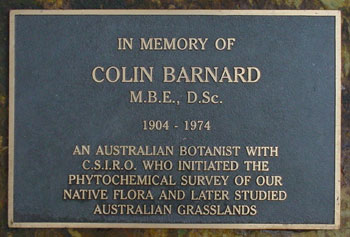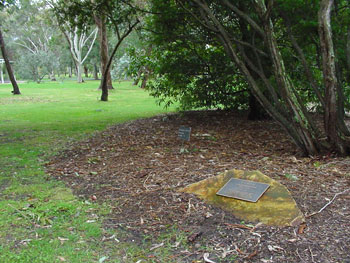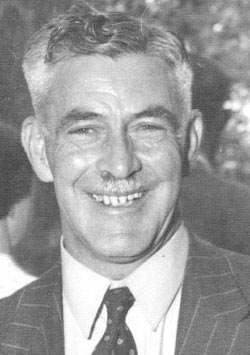![Director of National Parks [logo]](/images/dnp_90px.gif)


![Director of National Parks [logo]](/images/dnp_90px.gif) |
 |
 |

|

|
In the Australian National Botanic Gardens, about five metres downhill from the Nancy Burbidge Amphitheatre is a large Tallowwood, Eucalyptus microcorys. In the shade of that tree, on its lower side, in the adjacent bed (Section 37), is a plaque commemorating Dr Colin Barnard MBE, DSc (1904-1974).
The plaque was placed in position in May 1992.
Barnie, as he was known, spent almost the whole of his working life with CSIRO. In 1927 he joined what was then the Division of Economic Botany of CSIR and was seconded to the Commonwealth Research Station at Merbein, Victoria, and later transferred to Canberra. He studied growth and production in grape vines and developed a system for forecasting yield. He also worked on decline and dieback in apples.
In 1935 he assisted Dr. B. T. Dickson with his Report proposing the establishment of a botanic gardens in Canberra, and took the photos included with that report.
During World War II Dr Barnard was in charge of the production of exotic plants by CSIR to supply drugs such as morphine, hyoscine, strychnine and quinine. Later his group investigated native plants, such as Duboisia, of pharmacological and insecticidal value as possible substitutes for, or alternative sources of, imported drugs. L.J. Webb, later an authority on rainforest ecology, was appointed to expand the collection of native plant species.
 Colin Barnard, 1954 |
In 1944 Dr Barnard approached the CSIR Division of Industrial Chemistry for assistance in research on the alkaloids from Australian native plants. Dr J.R. Price who was appointed for this work later became Chairman of CSIRO. When the war was over and the urgency for drug production was reduced, it was accepted that exploring the chemical and pharmacological potential of the flora of Australia and Papua and New Guinea was a worthwhile contribution to the mapping of Australia's natural resources. Hence a collaboration between CSIRO and chemists in universities developed into the Australian Phytochemical Survey. It continued for about 25 years to the early 1970s.
In 1951 Dr Barnard had turned his attention to a detailed study of the growth of floral parts in wheat plants and later to a systematic study of all the monocotyledons. He established the Herbage Plant Registration Authority and as its Registrar was responsible for preparing authoritative descriptions, origins and identification of all herbage plant cultivars registered in Australia.
In 1964 Dr Barnard edited the book Grasses and Grasslands which covered the accumulated knowledge of Divisional research staff on the biology of grasses and on the problems of pasture establishment, maintenance and improvement.
Based on an article by Bernard Fennesy for the Friends of
the ANBG, 2002.